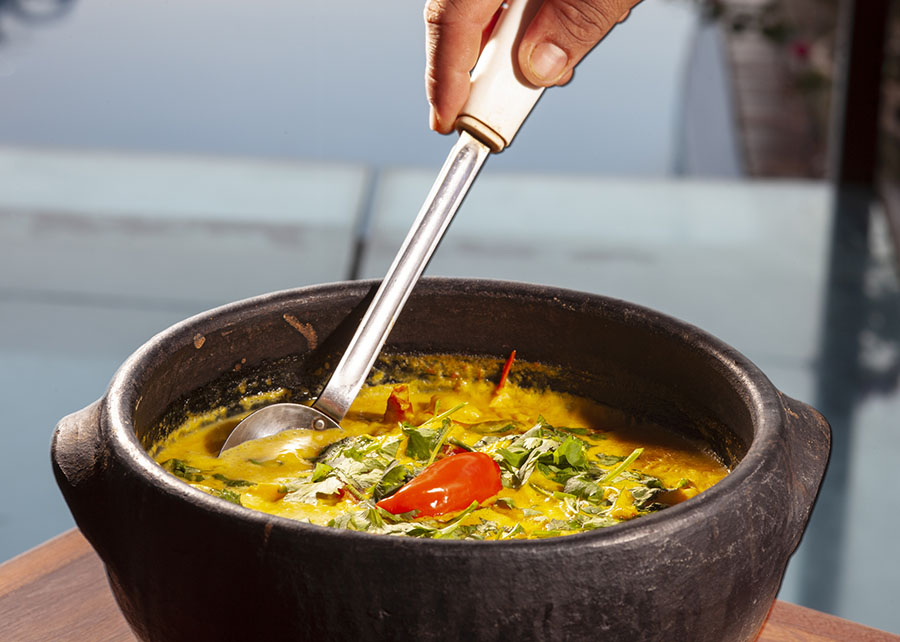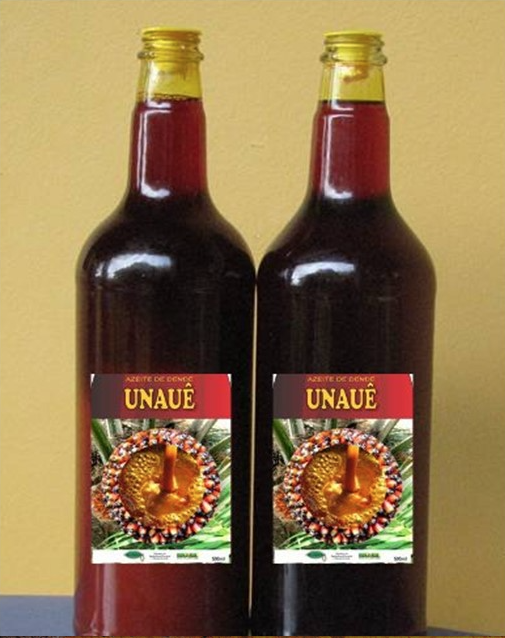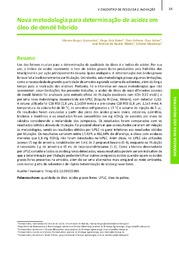Ceplac's experiments with a hybrid variety of palm oil from Embrapa (HIE OXG) resulted in a new oil, with lower acidity and more flavor. The product results from crossing African oil palm (Elaeis guineensis) and American oil palm (Elaeis oleífera). As it was developed at Ceplac's experimental field in Una, BA, it was named Unaué. The slow growth of hybrid HIE OXG The slow growth of hybrid HIE OXG makes it a viable option for family farming, as it requires less labor and extends the period of commercial viability. It also benefits the sustainability of the state's oil palm farming because it offers resistance to the worst pest that attacks the crop, Red Ring Disease (RRD). The new oil adds value to the Bahian cuisine as it also has functional properties. Experiments conducted by the Executive Commission of the Cocoa Farming Plan (Ceplac) with a hybrid oil palm variety developed by Embrapa Western Amazon resulted in the production of a new type of oil with low acidity and milder flavor. The solution directly impacts Bahian cuisine, since the high acidity of palm oil is reputed to be responsible for gastrointestinal disorders, which pushes appreciators away. Cultivating the hybrid can also contribute to the sustainability of oil palm farming in the region, especially for smallholders, as they combine low cost of production with pest resistance. The new oil developed at the Lemos Maia Experimental Station (Esmai/Ceplac), in the town of Una, Bahia, results from crossing the African oil palm that is locally known as dendê (Elaeis guineensis) and the American oil palm known as caiaué (Elaeis oleífera), to create the interspecific hybrid HIE OxG. Named Unaué, the new palm oil was tested in restaurants in the town, with good acceptance both in terms of flavor and quality. The product inherited the low acidity and the high concentration of fatty acids (good for the heart) from American palm oil, and is clearer and more uniform. As it offers a high percentage of olein, it is recommended for the preparation of the typical fish stews known as moquecas, frittatas, cassava, chicken, etc. Meanwhile the version for acarajés or àkàràs comes with significant stearin content, because the woman cooks who typically prepare them, the baianas, prefer an oil with more fat. Ceplac's researcher Jose Inácio Lacerda Moura points to future work in partnership with Embrapa aimed at the distribution of hybrid seedlings to farmers, especially family farmers, who are willing to produce and process palm oil in their properties. The hybrid notably grows to low heights, which reduces harvest costs, and offers moderate resistance to pests and diseases, especially Red Ring, a common and highly lethal disease to African oil palm (Tenera) - check more details in the box below. Oil quality benefits farmers and consumers The oil from HIE OxG has smaller amounts of free fatty acids than African palm oil and thus shows lower acidity and higher quality. It is also more insaturated and with higher content of vitamin E and carotenes. Studies have also demonstrated that the oil from the hybrid has potential for functional food preparation, as it is rich in polyphenols, has antioxidant properties and a favorable impact on human plasmatic lipidis, which are related to cardiovascular risk factors. Due to such characteristics, the use of this oil, especially in recipes from traditional Bahia cuisine whose key ingredient is unrefined palm oil, will provide products with better quality, flavor, and nutraceutical and functional properties. Considering HIE OxG's favorable agronomic and oil quality characteristics, it is thought that its cultivation can significantly contribute to the sustainability of Bahian oil palm farming, especially smallholdings, and further elevate traditional Bahian cuisine. In Bahia, where the crude (unrefined) palm oil has broad and important culinary uses, HIE OxG's quality benefits growers, who will be able to obtain higher compensation for the product, and consumers, who will have access to healthier and more quality products. Characteristics of the hybrid African oil palm (Elaeis guineenses Jacq.), pictured above, the world's main plant oil source, according to the United States Department of Agriculture (USDA) arrived in Brazil in the 16th century, brought by slaves from the African continent and disembarking in the state of Bahia, where it found in the Bahian Recôncavo region suitable climate and soil conditions to develop, originating the sub-spontaneous oil palm groves that currently exist in the region. Meanwhile American oil palm (Elaeis oleifera) is endemic of the humid tropical region of Latin America with spontaneous populations in Brazil, Colombia, Costa Rica, Equator, French Guyana, Honduras, Mexico, Nicaragua, Panama, Peru, Suriname and Venezuela. The Embrapa researchers Ricardo Lopes and Raimundo Cunha explain that the interespecific hybrid of these species (HIE OxG) has been explored in breeding programs in order to combine African oil palm's high oil yield with the resistance or tolerance to pests and diseases, smaller size and better oil quality of American oil palm. In 2010 Embrapa launched the first cultivar of HIE OxG developed in Brazil, named BRS Manicoré (photo to the right), obtained by crossing American oil palm sourced from Manicoré, Amazonas, with the 'La Mé' type of African oil palm. Ceplac's experiments with Embrapa's oil palm The experiments in Bahia with American oil palm started in 2009 and their findings have been publicized in a paper in the journal Agrotrópica, in April 2019, which was authored by the researchers Ricardo Lopes and Raimundo Cunha (Embrapa Western Amazon) and Sinval Pinto, Lindolfo Filho and José Moura (Ceplac). The researchers assessed that the hybrid, when compared with other oil palm cultivars, offers the advantages of lower heights, better oil quality and resistance to pests and diseases, especially Red Ring (RRD), caused by the nematode Bursaphelencus cocophilus Cobb, which is the main plant health problem in Bahian oil palm groves. Therefore, on top of HIE OxG's potential yield, they were interested in assessing the material's resistance to the disease. In the study, 12 HIE OxG progenies were assessed for their production of fresh fruit bunches (FFB) and resistance to Red Ring Disease. The experiment was set up in 2009, at Ceplac/Esmai's field, when blocks were randomly outlined with five repetitions and 12 plants per parcel. The assessments took place from the fourth to the eighth year of the establishment of the plantation. Their plant mortality due to RDD was 4%. HIE OxG offered high resistance to RDD and high yield potential, demonstrating a great potential for cultivation in Bahia. American oil palm is not affected by Red Ring Disease (RDD) Surveys conducted by Ceplac indicated that American oil palm is not affected by Red Ring disease, while African oil palm is susceptible and the hybrid (HIE OxG) has moderate resistance. The results refer to plantations of 25 years of age and analyzed the plants' mortality rate due to the incidence of the disease. With HIE OxG, a rate of approximately 7% was observed in a population of 250 plants, while in African oil palm groves during the same period, the mortality was high, 57% in a population of 3,853 plants. “The resistance to RDD present in HIE OxG is inherited from the American oil palm, since, after decades of planting the species in Esmai, no deaths were recorded as a result of the disease. Due to the large losses in Bahian oil palm farming and to the difficulty in controlling the disease, cultivating HIE OxG in the state is of high interest”, Moura explains. He underscores that, in addition to resistance to RDD, HIE OxG presents slow growth in height, which reduces harvest costs due to more efficient labor, and extends the period of viability for the commercial exploration of the plantations.

Named Unaué, the new palm oil was tested in restaurants in the village of Una, Bahia, with good acceptance both in terms of flavor and quality
-
Ceplac's experiments with a hybrid variety of palm oil from Embrapa (HIE OXG) resulted in a new oil, with lower acidity and more flavor. -
The product results from crossing African oil palm (Elaeis guineensis) and American oil palm (Elaeis oleífera). -
As it was developed at Ceplac's experimental field in Una, BA, it was named Unaué. -
The slow growth of hybrid HIE OXG The slow growth of hybrid HIE OXG makes it a viable option for family farming, as it requires less labor and extends the period of commercial viability. -
It also benefits the sustainability of the state's oil palm farming because it offers resistance to the worst pest that attacks the crop, Red Ring Disease (RRD). -
The new oil adds value to the Bahian cuisine as it also has functional properties. |
Experiments conducted by the Executive Commission of the Cocoa Farming Plan (Ceplac) with a hybrid oil palm variety developed by Embrapa Western Amazon resulted in the production of a new type of oil with low acidity and milder flavor. The solution directly impacts Bahian cuisine, since the high acidity of palm oil is reputed to be responsible for gastrointestinal disorders, which pushes appreciators away. Cultivating the hybrid can also contribute to the sustainability of oil palm farming in the region, especially for smallholders, as they combine low cost of production with pest resistance.
The new oil developed at the Lemos Maia Experimental Station (Esmai/Ceplac), in the town of Una, Bahia, results from crossing the African oil palm that is locally known as dendê (Elaeis guineensis) and the American oil palm known as caiaué (Elaeis oleífera), to create the interspecific hybrid HIE OxG. Named Unaué, the new palm oil was tested in restaurants in the town, with good acceptance both in terms of flavor and quality.
The product inherited the low acidity and the high concentration of fatty acids (good for the heart) from American palm oil, and is clearer and more uniform. As it offers a high percentage of olein, it is recommended for the preparation of the typical fish stews known as moquecas, frittatas, cassava, chicken, etc. Meanwhile the version for acarajés or àkàràs comes with significant stearin content, because the woman cooks who typically prepare them, the baianas, prefer an oil with more fat.
Ceplac's researcher Jose Inácio Lacerda Moura points to future work in partnership with Embrapa aimed at the distribution of hybrid seedlings to farmers, especially family farmers, who are willing to produce and process palm oil in their properties. The hybrid notably grows to low heights, which reduces harvest costs, and offers moderate resistance to pests and diseases, especially Red Ring, a common and highly lethal disease to African oil palm (Tenera) - check more details in the box below.
 Oil quality benefits farmers and consumers Oil quality benefits farmers and consumers
The oil from HIE OxG has smaller amounts of free fatty acids than African palm oil and thus shows lower acidity and higher quality. It is also more insaturated and with higher content of vitamin E and carotenes. Studies have also demonstrated that the oil from the hybrid has potential for functional food preparation,  as it is rich in polyphenols, has antioxidant properties and a favorable impact on human plasmatic lipidis, which are related to cardiovascular risk factors. Due to such characteristics, the use of this oil, especially in recipes from traditional Bahia cuisine whose key ingredient is unrefined palm oil, will provide products with better quality, flavor, and nutraceutical and functional properties. as it is rich in polyphenols, has antioxidant properties and a favorable impact on human plasmatic lipidis, which are related to cardiovascular risk factors. Due to such characteristics, the use of this oil, especially in recipes from traditional Bahia cuisine whose key ingredient is unrefined palm oil, will provide products with better quality, flavor, and nutraceutical and functional properties. Considering HIE OxG's favorable agronomic and oil quality characteristics, it is thought that its cultivation can significantly contribute to the sustainability of Bahian oil palm farming, especially smallholdings, and further elevate traditional Bahian cuisine. In Bahia, where the crude (unrefined) palm oil has broad and important culinary uses, HIE OxG's quality benefits growers, who will be able to obtain higher compensation for the product, and consumers, who will have access to healthier and more quality products. |
Characteristics of the hybrid

African oil palm (Elaeis guineenses Jacq.), pictured above, the world's main plant oil source, according to the United States Department of Agriculture (USDA) arrived in Brazil in the 16th century, brought by slaves from the African continent and disembarking in the state of Bahia, where it found in the Bahian Recôncavo region suitable climate and soil conditions to develop, originating the sub-spontaneous oil palm groves that currently exist in the region.
 Meanwhile American oil palm (Elaeis oleifera) is endemic of the humid tropical region of Latin America with spontaneous populations in Brazil, Colombia, Costa Rica, Equator, French Guyana, Honduras, Mexico, Nicaragua, Panama, Peru, Suriname and Venezuela.
Meanwhile American oil palm (Elaeis oleifera) is endemic of the humid tropical region of Latin America with spontaneous populations in Brazil, Colombia, Costa Rica, Equator, French Guyana, Honduras, Mexico, Nicaragua, Panama, Peru, Suriname and Venezuela.
The Embrapa researchers Ricardo Lopes and Raimundo Cunha explain that the interespecific hybrid of these species (HIE OxG) has been explored in breeding programs in order to combine African oil palm's high oil yield with the resistance or tolerance to pests and diseases, smaller size and better oil quality of American oil palm. In 2010 Embrapa launched the first cultivar of HIE OxG developed in Brazil, named BRS Manicoré (photo to the right), obtained by crossing American oil palm sourced from Manicoré, Amazonas, with the 'La Mé' type of African oil palm.
Ceplac's experiments with Embrapa's oil palm The experiments in Bahia with American oil palm started in 2009 and their findings have been publicized in a paper in the journal Agrotrópica, in April 2019, which was authored by the researchers Ricardo Lopes and Raimundo Cunha (Embrapa Western Amazon) and Sinval Pinto, Lindolfo Filho and José Moura (Ceplac). The researchers assessed that the hybrid, when compared with other oil palm cultivars, offers the advantages of lower heights, better oil quality and resistance to pests and diseases, especially Red Ring (RRD), caused by the nematode Bursaphelencus cocophilus Cobb, which is the main plant health problem in Bahian oil palm groves. Therefore, on top of HIE OxG's potential yield, they were interested in assessing the material's resistance to the disease. In the study, 12 HIE OxG progenies were assessed for their production of fresh fruit bunches (FFB) and resistance to Red Ring Disease. The experiment was set up in 2009, at Ceplac/Esmai's field, when blocks were randomly outlined with five repetitions and 12 plants per parcel. The assessments took place from the fourth to the eighth year of the establishment of the plantation. Their plant mortality due to RDD was 4%. HIE OxG offered high resistance to RDD and high yield potential, demonstrating a great potential for cultivation in Bahia. |
American oil palm is not affected by Red Ring Disease (RDD)
Surveys conducted by Ceplac indicated that American oil palm is not affected by Red Ring disease, while African oil palm is susceptible and the hybrid (HIE OxG) has moderate resistance. The results refer to plantations of 25 years of age and analyzed the plants' mortality rate due to the incidence of the disease. With HIE OxG, a rate of approximately 7% was observed in a population of 250 plants, while in African oil palm groves during the same period, the mortality was high, 57% in a population of 3,853 plants.
“The resistance to RDD present in HIE OxG is inherited from the American oil palm, since, after decades of planting the species in Esmai, no deaths were recorded as a result of the disease. Due to the large losses in Bahian oil palm farming and to the difficulty in controlling the disease, cultivating HIE OxG in the state is of high interest”, Moura explains.
He underscores that, in addition to resistance to RDD, HIE OxG presents slow growth in height, which reduces harvest costs due to more efficient labor, and extends the period of viability for the commercial exploration of the plantations.
Maria José Tupinambá (114 MTb/AM)
Embrapa Western Amazon
Press inquiries
maria.tupinamba@embrapa.br
Phone number: +55 92 99132-1112
Mariana Medeiros - Translation (013044/DF)
General Secretariat
Further information on the topic
Citizen Attention Service (SAC)
www.embrapa.br/contact-us/sac/

Meanwhile American oil palm (Elaeis oleifera) is endemic of the humid tropical region of Latin America with spontaneous populations in Brazil, Colombia, Costa Rica, Equator, French Guyana, Honduras, Mexico, Nicaragua, Panama, Peru, Suriname and Venezuela.

